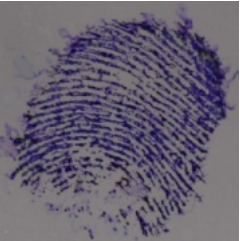Matt Shindelus- Contra Costa County Sheriff’s Office
Cindy Hull- C. K. Hull & Associates- Forensic Consulting Services
In an effort to test the effectiveness and reliability of Aqueous Leuco Crystal Violet (LCV), bloody fingerprints were treated with LCV and their development was observed. The prints were inspected for pitting, running, bleeding, darkening, and other forms of damage.
The study was conducted between November 23 and December 2, 2009. Fresh human blood was applied to the fingers of the analyst and bloody fingerprints were placed on the bottoms of Pyrex pans. The prints were allowed to dry overnight and then sprayed with LCV. The LCV was from a kit purchased from the Sirchie Finger Print Laboratories. The kit was received on November 9, 2009 and was mixed on November 23, 2009. The LCV was allowed to interact with the prints for 5 minutes and then the development was arrested. The prints were photographed before being treated, immediately after development was arrested, and every 30 minutes after that for the next 2 hours.
Multiple variables were experimented with in order to test their effect on the development of the prints. During the spraying of the LCV, some prints were in an upright position, while others were laid flat (all of the prints were in an upright position when they were rinsed with water). Three different methods were used to arrest the development. The prints were either rinsed with water, blotted with a paper towel, or were allowed to continue to develop. Also, some of the prints received a second treatment of LCV.
The prints that were sprayed with LCV while lying flat had very little damage. The heavier,thicker prints had a small amount of bleeding when they were sprayed (see Figure 1) and a small amount of running when they were rinsed (see Figure 2). The light prints had no damage at all and were fully developed (see Figure 3).
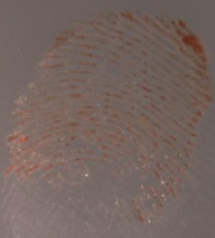

Figure 1. Bleeding of LCV dye on a heavier blood print after spraying with LCV in flat position.
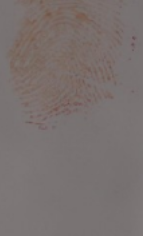

Figure 2. Running of LCV dye (sprayed in a flat position) on a heavier blood print after rinsing with water.
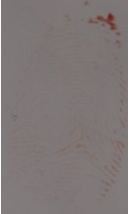

Figure 3. Enhancement of faint blood print with LCV (sprayed while in a flat position).
The prints that were in an upright position when they were sprayed with LCV had some damage. The lighter prints had very little damage (see Figure 4), but the heavier, thicker prints had significant damage. There was a large amount of pooling when sprayed (see Figure 5) and some running when rinsed (see Figure 6). Despite the pooling and running, the general integrity was preserved for most prints (see Figures 7 and 8).


Figure 4. Enhancement of faint blood print with LCV (sprayed while in an upright position).


Figure 5. Bleeding of LCV on a heavier blood print after spraying with LCV in an upright position.


Figure 6. Running of LCV (sprayed while in an upright position) on a heavier blood print after rinsing with water.
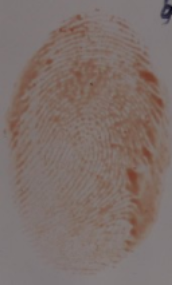

Figure 7. Treatment of heavy blood print with LCV (sprayed while in an upright position).
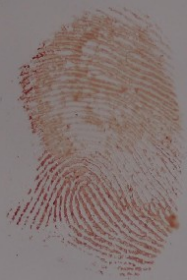

Figure 8. Treatment of heavy blood print with LCV (sprayed while in an upright position).
There were various problems that were encountered during the study. When prints were not blotted, the rinse water (see Figure 9) or the remaining LCV (see Figures 10 and 11) would pool between the ridges of the prints. Prints that were very heavy suffered from pitting. In most cases, this only affected the areas that were too thick to have identifiable ridges (see Figure 12), however some ridges were dense enough to be destroyed by the LCV (see Figure 13). Some prints had ridges which were heavy enough that the top layer was washed away when sprayed. These prints could be retreated with LCV to obtain a quality print (see Figure 14). Some prints appeared to be composed of blood, but were actually only partially bloody prints and partially normal oil prints. When sprayed with LCV, the oil based area of the print would be destroyed (see Figure 15).
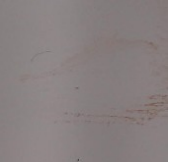

Figure 9. Rinse water pooling on an LCV treated print.


Figure 10. Unarrested LCV pooling between the ridges of a print.


Figure 11. Unarrested LCV pooling between the ridges of a print.


Figure 12. Very heavy print showing pitting after being treated with LCV.


Figure 13. Ridge detail of very heavy print destroyed when treated with LCV.



Figure 14. Blood print requiring two treatments with LCV.


Figure 15. Oil based print destroyed when treated with LCV.
To decrease the amount of pooling, the prints should be blotted to arrest the LCV or they should be rinsed and the excess water blotted. Prints that are not flat should be blotted instead of sprayed in order to reduce potential damage from running. Prints that are easily visible should not be treated with LCV unless they have been thoroughly photographed. Prints that may possibly contain areas without blood should first be dusted with black powder. They can then be treated with LCV without any damage to the bloody area of the print and without any impairment of the staining process (see Figure 16).



Figure 16. Print composed of both blood and oil. The print was dusted with black powder and then treated with LCV.
Moderate to light prints on a flat surface that were blotted or rinsed produced an ideal stain for testing the development process. Based on the results of this test, we recommend that we move on to the next phase of the study, determining what effect sunlight, temperature, humidity, and time have on the development rate of the LCV.

